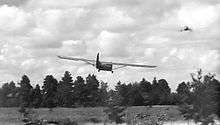Glider snatch pick-up technique
The glider snatch pick-up technique was used by the Allies of World War II. It allowed military gliders to be launched from a stationary position on the ground by a low-flying powered aircraft (the tow or tug), flying low overhead, which did not have to land.[1]

The snatching aircraft, typically a Douglas C-47 Skytrain ("Dakota"), had a 20 ft arm hanging down at a 45-degree angle, supporting a hook at the tip. The hook was attached to a steel rope attached to an automatic winch, containing 1000 ft of steel cable. On flyover, the hook engaged in a square-shaped loop of nylon tow rope, supported on two poles about 20 ft apart and 10 ft off the ground. This loop was attached to a 180 ft nylon tow rope attached to the front of the glider. The special design of the hook meant it was less likely to snag the ground but would grab the loop.
When the hook engaged in the loop, the rope initially paid out from the winch, and then gradually a brake was automatically applied until up to 800 ft of cable had been paid out. This, and the stretch in the nylon rope, reduced shock loading to less than 1 g for a duration of around 3 to 6 seconds, by which time the glider would be airborne. The steel wire was then winched in. It was possible for one plane to pick up two gliders in this way, in two passes. Gliders could be retrieved for re-use in this way after combat operations.
Some casualties were evacuated from the D-Day landings back to the United Kingdom using this technique. Several rescues of downed aircraft passengers were also performed by landing gliders to pick up survivors and then snatching them from remote locations. [2] [3]
Also see
References
- ESCO Arresting (31 March 2009). "All American Aviation and the US Army Glider Pick-ups" – via YouTube.
- https://www.mylubbock.us/docs/silent-wings-museum-file-library/retrievalsystem.pdf?sfvrsn=2
- Mrazek, J.E. (2011). Airborne Combat: The Glider War/Fighting Gliders of WWII. Stackpole Books. p. 417. ISBN 9780811744669. Retrieved 2017-01-07.